![]()
HISTORY OF BINGHAM
Binghams Railways
On the 16th July 1846 an Act of Parliament gave authority for the Ambergate, Nottingham and Boston and Eastern Junction Railway Company to build a line serving the towns and regions listed in its title. This was a grand and ambitious scheme even for this time of the early railway boom and it soon became clear that sufficient finances were not available and that other competing schemes were already beginning to establish themselves over the same territory. However an agreement was made with the Midland Railway, which allowed the ANB & EJ Railway to build a line linking Grantham with Nottingham. It joined the Midland line at Colwick and ran into the Midland's Nottingham station. This line opened for business on the 15th July 1850 with its own independent station at Grantham. This latter arrangement did not last long. The Great Northern Railway reached Grantham in 1852 and it soon became clear that it was to the advantage of the ANB & EJ Railway to close their station and arrange to run their Nottingham to Grantham trains into the new GNR main line station.
This collaboration with the GNR was soon extended through an 1855 agreement that the GNR's trains should be allowed to travel into Nottingham over the ANB & EJ Railway's line and into the Nottingham Midland station. It appears that the Midland Railway Company was not party to this agreement since, when the first GNR train arrived in Nottingham the Midland claimed it was trespassing, seized the locomotive, hauled it away to a shed and removed the lines to prevent the GNR getting it back whilst litigation took place - a long and costly process. The outcome was that the GNR built their own connection from Colwick into Nottingham with the terminus at what became known as the London Road Low Level Station, which can still be seen today functioning as a Health and Fitness Club at the north end of London Road. The Colwick link was not used again until after the closure of Nottingham's Victoria station in September 1967.
The line that ran along the course of what is now the Linear Walk was the second line to be built in Bingham. An Act of Parliament passed in 1874 authorised the GNR and the London & North Western Railway to build a joint line to link Newark with Market Harborough with a branch from Marfield to Leicester (Belgrave Gate) and a second branch from Harby and Stathern to form a junction with the Grantham to Nottingham line at Saxondale and then on to the GNR terminus at Nottingham, London Road Low Level station.
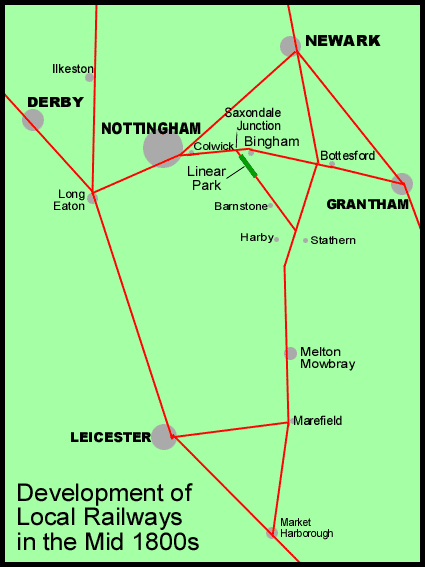
This line (above) from Saxondale opened for goods traffic as far as Melton Mowbray in July 1879 and for passengers in the following September. A station known as Bingham Road together with a Station Master's house was built at a point not far from where the present Linear Walk starts on Nottingham Road; the station house is still there as a private residence. It was at this point that a bridge took the line across Nottingham Road and along an embankment across what is now the Wynhill Estate. The line was never popular with travellers as the service was slow and infrequent but significant freight was carried. The GNR used the line to move iron ore from east Leicestershire to the Stanton Ironworks at Ilkeston and the LNWR moved coal from the Notts and Derby Coalfields to London. Bingham Road station was closed in July 1951 and the line from Saxondale Junction to Barnstone was closed to all traffic on the 9th. September 1962, with the line and the bridge being dismantled shortly afterwards. In 1964 plans were announced to close passenger stations on the Nottingham to Grantham line, including Bingham, but that was averted.
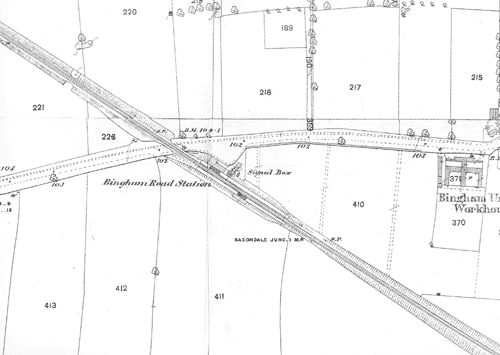
1884 map of the area around Bingham Road station
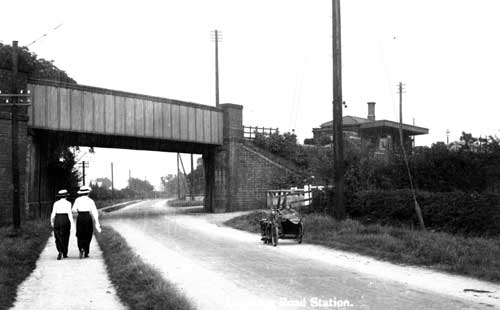
Bingham Road station and the road bridge, taken before 1914. The bridge, station and embankments were removed after closure of the line in 1962. The original picture was published as a postcard by E Richardson of Bingham. It is used here by permission of Hugh Holbrook.
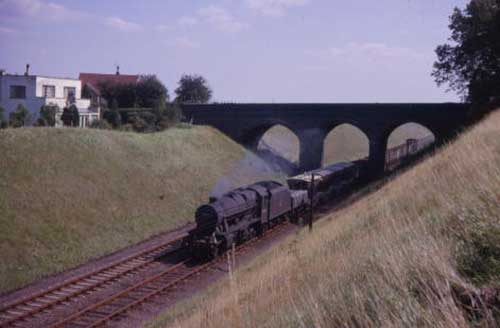
Tithby Road bridge taken in September 1962, the last month of operation of this line (Photo: John Clarke).
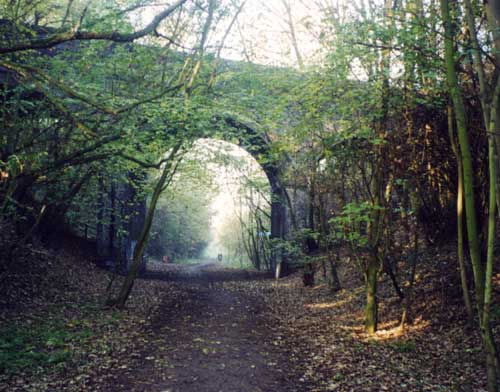
Tithby Road bridge in November 2001, now crossing the Linear Park (Photo: Peter Allen).
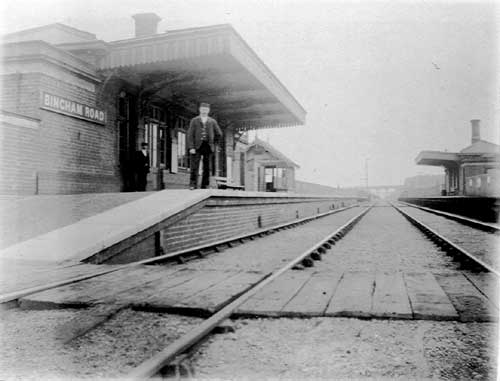
Bingham Road station in about 1908. Down the line three bridges can be seen. The nearest is Tithby Road bridge. Two more can be seen beyond it. Dot Mabbott recalls that there were three: the nearest was Folly Bridge named after Fewster’s Folly, an orchard reached via the bridge, then Knight’s Bridge, which presumably went to Knight’s farm and Plott Bridge. This one is interesting because the 1840 tithe map shows that the area crossed by the line hereabouts was called Plotts, a name commonly used for medieval furlongs. Now there are only the Tithby Road bridge and two other brick arch bridges remaining.
Photo by permission of Dot Mabbott.
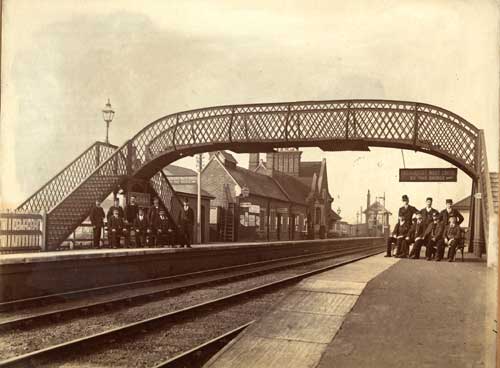
Bingham station some time before 1914. The men are thought to be the staff of the two Bingham stations. The original photo is by H. Whittlesey, Netherfield, Nottingham.
By permission of Mrs P.A. Godson
Credits
The text was written with reference to:
'A short history of the Linear Walk': David Newton.
'Collaboration and Conflict east of Colwick': John Clarke.
Published in Steam World; Issue 154; April 2000.
Thanks are also due to Richard Strange and the Bingham Town Council for useful information.
